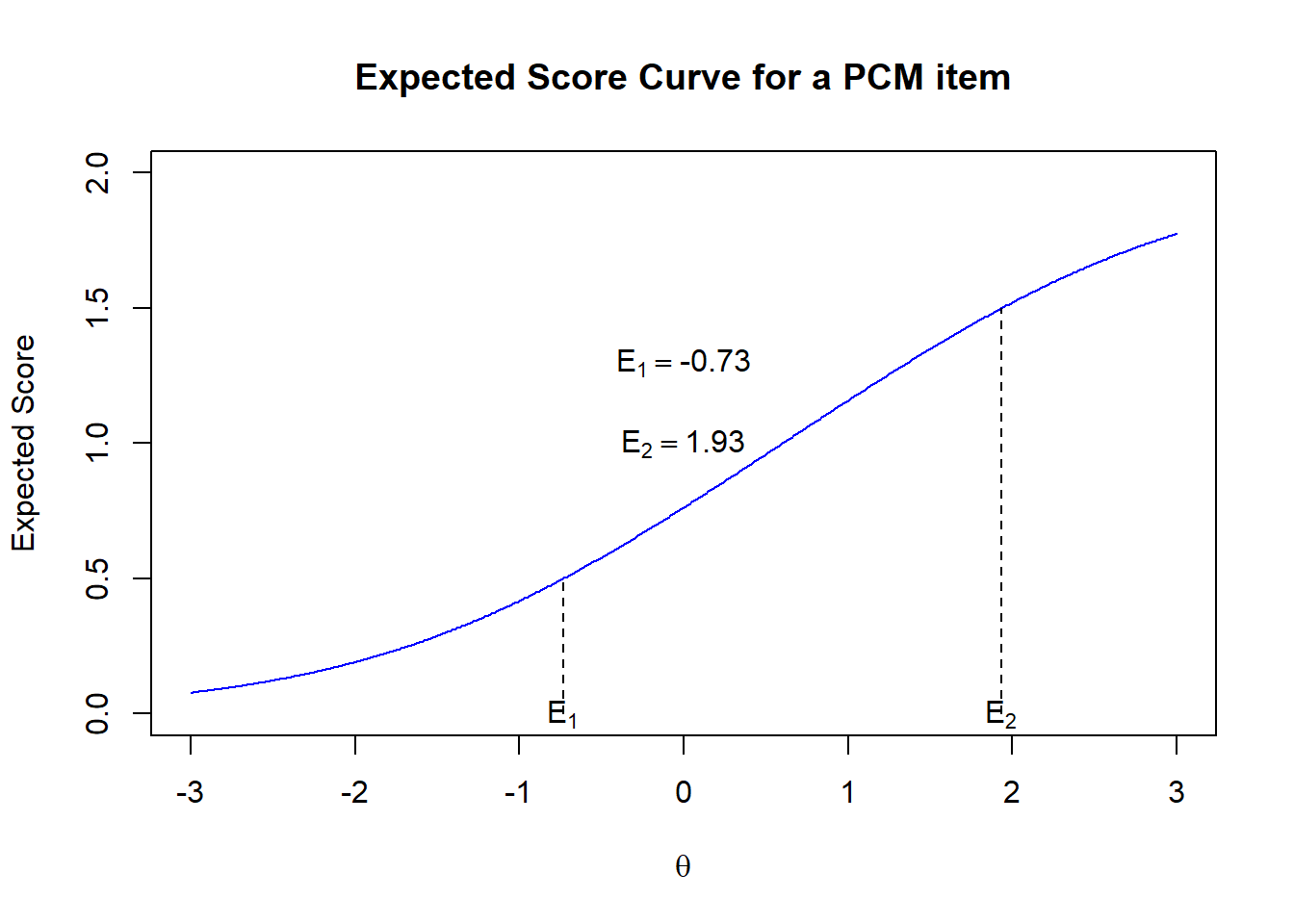Another way to think of item difficulty for each score point of a PCM item is to calculate the expected score as a function of ability, and then find the ability at which the expected score is 0, 1, 2, etc.
Between the ability range of -0.73 and 1.93, the expected score is between 0.5 and 1.5. We may call this ability range of the score 1 region. Below -0.73, the expected score is closer to 0 than closer to 1, so this region is the score 0 region. Above an ability of 1.93, the expected score is closer to 2 than closer to 1, so this may be the score 2 region. In this way, -0.73 and 1.93 may be regarded as item difficulty measures for a PCM item.
How do we derive the expected score of 0.5 for a person with ability -0.73?
We calculate the probability of their scores in each category, multiply by the category score, and then sum them. So, theta = -0.73, δ1 = -0.5 and δ2 = 1.7.
\[
Prob(X=1) = \frac{\exp(\theta - \delta_1)}{1+\exp(\theta - \delta_1) + \exp(2\theta - \delta_1 - \delta_2)}
\tag{26.1}\]
\[
Prob(X=1) = \frac{\exp(-0.73 - -0.5)}{1+\exp(-0.73 - -0.5) + \exp(2* -0.73 - -0.5 - 1.7)}
\tag{26.2}\]
\[
Prob(X=1) = \frac{0.7945336}{1+0.7945336 + 0.06994822}
\tag{26.3}\]
\[
Prob(X=1) = 0.4261418
\tag{26.4}\]
\[
Prob(X=2) = \frac{\exp(2\theta - \delta_1 - \delta_2)}{1+\exp(\theta - \delta_1) + \exp(2\theta - \delta_1 - \delta_2)}
\tag{26.5}\]
\[
Prob(X=2) = \frac{\exp(2*-0.73 - -0.5 - 1.7)}{1+\exp(-0.73 - -0.5) + \exp(2*-0.73 * - -0.5 - 1.7)}
\tag{26.6}\]
\[
Prob(X=2) = \frac{0.06994822}{1+0.7945336 + 0.08803683}
\tag{26.7}\]
\[
Prob(X=2) = 0.0371557
\tag{26.8}\]
We can then add the probabilities to derive the expected score:
\[
E (-0.7)) = 0.4261418 + (2 * 0.0371557) = 0.5
\tag{26.9}\]
Extension activity
Now do the same for E = 1.93
Andrich, David, and Ida Marais. 2019.
“The Idea of Measurement.” In
A Course in Rasch Measurement Theory, 3–11. Springer Nature Singapore.
https://doi.org/10.1007/978-981-13-7496-8_1.
Bond, Trevor G., Zi Yan, and Moritz Heene. 2020.
Applying the Rasch Model: Fundamental Measurement in the Human Sciences. Routledge.
https://doi.org/10.4324/9780429030499.
Cappelleri, Jason Lundy, J. C. 2014.
“Overview of Classical Test Theory and Item Response Theory for the Quantitative Assessment of Items in Developing Patient-Reported Outcomes Measures.” Clinical Therapeutics 36 (5): 648–62. https://doi.org/
https://doi.org/10.1016/j.clinthera.2014.04.006.
Cronbach, Lee J. 1951.
“Coefficient Alpha and the Internal Structure of Tests.” Psychometrika 16 (3): 297–334.
https://doi.org/10.1007/bf02310555.
Goldstein, H., and Steve Blinkhorn. 1982.
“The Rasch Model Still Does Not Fit.” British Educational Research Journal 8 (2): 167–70.
https://doi.org/10.1080/0141192820080207.
Lord, Frederic M, and Melvin R Novick. 2008. Statistical Theories of Mental Test Scores. IAP.
McNeish, Daniel. 2018.
“Thanks Coefficient Alpha, We’ll Take It from Here.” Psychological Methods 23 (3): 412–33.
https://doi.org/10.1037/met0000144.
Panayides, Panayiotis, Colin Robinson, and Peter Tymms. 2010.
“The Assessment Revolution That Has Passed England by: Rasch Measurement.” British Educational Research Journal 36 (4): 611–26.
https://doi.org/10.1080/01411920903018182.
Robitzsch, Alexander, Thomas Kiefer, and Margaret Wu. 2022.
TAM: Test Analysis Modules.
https://CRAN.R-project.org/package=TAM.
Sijtsma, Klaas. 2008.
“On the Use, the Misuse, and the Very Limited Usefulness of Cronbach’s Alpha.” Psychometrika 74 (1): 107–20.
https://doi.org/10.1007/s11336-008-9101-0.
Wright, Benjamin D, and Magdalena Mok. 2000. “Rasch Models Overview.” Journal of Applied Measurement 1 (1): 83–106.
